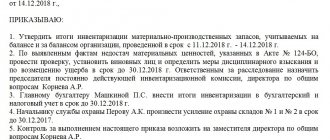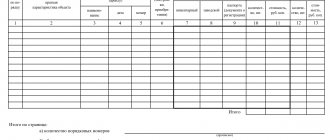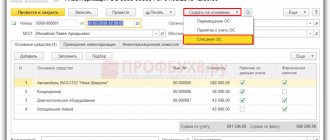Inventory is a responsible and serious process for entrepreneurs involved in retail trade. Almost every businessman involved in the sale of a wide range of goods has encountered mis-grading in his work.
- What is this phenomenon?
- Why might it occur?
- How to minimize its occurrence?
- And if it is nevertheless identified, how to correctly reflect the misgrading in accounting and tax records?
We will help clarify all questions regarding regrading in this material.
How to take inventory during reorganization ?
ACT No.____dated “_____”____20___ about shortages and/or mis-grading of goods
1. Name of organization ________________________________________________________________________________
2. Full name of the authorized person _____________________________________________________________________
3. Supplier delivery note and invoice number _____________________________________________________
4. Transport company __________________________________________________________ according to transport invoices No. _______________________________________________________________
5. Condition of containers and packaging of products ____________________________________________________________
6. Number of places according to the supplier’s invoice ____________________________________________________________
7. Number of places actually received ____________________________________________________________
8. Detailed description of the product:
| № | Name of product | Description of packaging | According to the documents | Actually |
| Qty | Value with VAT | Qty | Value with VAT | |
| 1 | ||||
| 2 | ||||
| 3 | ||||
| 4 | ||||
| 5 |
Total amount of shortage and/or misgrading, rub. (in words) _________________________________________________
_________________________________________________________________________________ including VAT, rub. (in words) ___________________________________________________________________________________
The act is drawn up by a commission consisting of representatives of the supplier and buyer. Members of the commission are responsible for signing an act containing data that does not correspond to reality.
Position_______________________signature_________________________Full name__________________________
Position_______________________signature_________________________Full name__________________________
M.P.
Documents found on the topic “act of regrading of goods sample”
- Act on shortage and (or) mis-grading of goods Documents of the enterprise's office work → Act on shortage and (or) mis-grading of goods
Act No. dated ""20. about shortage and (or) misgrading of goods 1. name of the organization 2. full name of the authorized person... - Sample. Act control check of correct loading of products (goods)
Contract for the carriage of goods and passengers → Sample. Certificate of control verification of the correct loading of products (goods)act of control verification of the correct loading of products ( goods ) name and details of the enterprise: “” 20, no...
- Sample. Act for damage, fight, scrap goods (material). Form No. 12
Accounting statements, accounting → Sample. Act of damage, damage, scrap of goods (material). Form No. 12...its markdown (write-off) due to the material. (damage, battle, etc.) as a result of the inspection it turned out: - no. quantity actir markdown sum pre- +- +-markdowns skur.name of goods , sorted.gross netto price sum newamount or materials, art...
- Sample. Act for transmission goods, containers and equipment when changing bartenders
Accounting statements, accounting → Sample. Act on the transfer of goods, containers and equipment when changing barmenOkud code 0903115 (enterprise, organization) act no. for the transfer of goods , containers and equipment when changing bartenders on 20. handing over: receiving: (position, function...
- Sample. Act about detection of shortage of products (goods) when opening a carriage (container, van)
Contract for the carriage of goods and passengers → Sample. Report on detection of shortage of products (goods) upon opening of a carriage (container, van)(name of the recipient) (address of the recipient) act on the discovery of a shortage of products ( goods ) when opening a carriage (container, van) "" 200, place of drawing up...
- Sample. Act about the established discrepancy in quantity when accepting imported goods. Specialized form No. 2-on
Agreement for the supply of goods and products → Sample. An act on the established discrepancy in quantity when accepting imported goods. Specialized form No. 2-onspecialized form no.2-on +-+ code according to okud 0903002 +-+ “I approve” “” 20 act no. dated "" 20 about the established discrepancy in quantity when accepting imported goods place of drawing up the act : ...
- Sample. Act inventory goods shipped. Form No. inv-4 (order of the Ministry of Finance of the Russian Federation dated June 13, 1995 No. 49)
Accounting statements, accounting → Sample. Inventory report of goods shipped. Form No. inv-4 (order of the Ministry of Finance of the Russian Federation dated June 13, 1995 No. 49)... financial obligations approved by order of the Ministry of Finance of the Russian Federation dated June 13, 1995 no. 49 act of inventory of goods shipped no. +-+ codes +- form no. inv-4 according to okud 0309004 +- organization according to okd...
- Sample. Act about the established discrepancy in quantity and quality upon admission goods (material). Form No. 115
Agreement for the supply of goods and products → Sample. An act on the established discrepancy in quantity and quality upon receipt of goods (material). Form No. 115organization standard form no. 115 enterprise - act no. about the established discrepancy of goods in quantity and quality upon receipt - material "" 20g. place of origin...
- Sample. Act inventory of materials and goodson the way (order of the Ministry of Finance of the Russian Federation dated June 13, 1995 No. 49)
Accounting statements, accounting → Sample. Inventory report of materials and goods in transit (order of the Ministry of Finance of the Russian Federation dated June 13, 1995 No. 49)... financial obligations approved by order of the Ministry of Finance of the Russian Federation dated June 13, 1995 no. 49 act of inventory of materials and goods in transit no. +-+ codes +- form no. inv-6 on okud 0309006 +- about...
- Sample. Act on detection of non-conformity of quality and completeness of products (goods) requirements of standards or other documents certifying quality when opening a carriage (container, van)
Contract for the carriage of goods and passengers → Sample. Act on the discovery of non-compliance of the quality and completeness of the product (goods) with the requirements of standards or other documents certifying the quality when opening a carriage (container, van)(name of the recipient) (address of the recipient) act on the discovery of non-compliance of the quality and completeness of the product ( goods ) with the requirements of the standard or other documents approved...
- Act on establishing discrepancies in quantity upon acceptance goods
Documents of the enterprise's office work → Act on establishing discrepancies in quantity upon acceptance of goodsact on establishing discrepancies in quantity upon acceptance of goods dated "" 20, name of organization ...
- Act about the return of defective goods
Enterprise records → Certificate of return of defective goodsAct No. dated "" 20 about the return of defective goods 1. name of the organization 2. full name of the authorized person...
- Act markdowns goods
Accounting statements, accounting → Certificate of markdown of goods...a couple in the commission trade of non-food products , approved by order of Roskomtorg dated December 7, 1994 no. 99 act of markdown "" 20, the commission agent represented by (last name, first name, patronymic) and the committent made a markdown (last name, first name, patronymic) ...
- Act absence goods required size
Statements of claim, complaints, petitions, claims → Act of lack of goods of the required sizeact of absence of goods of the required size "" 20g. This act was drawn up in the presence of the consumer, paspo...
- Form No. inv-4 Act inventory goods shipped
Accounting statements, accounting → Form No. inv-4 act of inventory of goods shippedact of inventory of goods shipped form no. inv-4 (enterprise, organization) form no. inv-4 approved by resolution...
Re-grading - what is it?
The term “re-grade” came to us from the Soviet heritage - it refers to goods of the same name, but of different grades.
It is officially mentioned in accounting documents, but tax legislation does not give it a strict definition.
Re-grading is the result of an inventory that reveals a discrepancy between goods of different types having the same name, and the shortage of one type of product is covered by a surplus of another type.
NOTE! The concept of “product name” is also not reflected in the regulatory framework, so it can be interpreted in different ways. The Ministry of Finance recommends using the data from the All-Russian Product Classifier.
For example, according to the inventory commission of a furniture store, according to the documents, the balance should have included 10 “Antoshka” and 8 “Masha and the Bear” chairs, but in fact it turned out to be 8 “Antoshka” and 10 “Masha”: thus, a surplus of 2 chairs is recorded "Antoshka" and a simultaneous shortage of 2 units of "Masha and the Bear". This means that some sold “Antoshka” chairs turned out to be capitalized as “Masha”.
Is it possible as a result of regrading in tax accounting
Official regulation of misgrading
During the Soviet Union, the concept of “regrading” was used quite widely, being in common use, so modern legislators did not consider it necessary to make additional adjustments to its regulation. There are only a few regulations that address this phenomenon.
- Among the regulatory documents relating to regrading, we can highlight the Letter of the Federal Tax Service of Moscow dated February 17, 2010 No. 16-15/016379 “On accounting for profit tax purposes of the balances of goods by an organization engaged in retail trade,” in which it is officially given the current definition of misgrading, and its possible causes are listed.
- The procedure for reconciling material assets, as a result of which, in particular, misgrading can be identified, has been in effect since July 13, 1995 - it was then that Order No. 49 of the Ministry of Finance of the Russian Federation came into force, which put into force the “Methodological Instructions for Inventory.”
- The accounting reflection of the re-grading of goods is carried out in accordance with clause 28 of the Accounting Regulations, which was approved by Order of the Ministry of Finance of the Russian Federation dated July 29, 1998 No. 34n.
Is it necessary to restore VAT if a shortage is detected ?
What is it about
Most often this problem arises during a warehouse audit. The storekeeper simply recalculates the product items and finds out that there is not enough orange juice to fill a package. This would be an act of shortage if the employee did not see that there were more cherries for the same box than needed. This is what is called re-grading - when there is less of one type, and more of another similar product.
Often the problem is the inattention of the personnel who accepted the raw materials or products. They do not control the nomenclature, taste, color or material, accepting by the number of boxes. Initially, the supplier makes a mistake - his employees inattentively look at the shipping list and load one variety instead of another.
If the organization accepts only boxed delivery and sale, then half the packaging cannot be mismatched. Only container volume - box, box, pallet. If there should be 8 bottles of lemonade in a package, then 3 of them will not be mixed with another soda. Because it couldn’t come in a sealed factory box with 5 bottles of one thing and 3 of something completely different.
Business Solutions
the shopsclothes, shoes, products, toys, cosmetics, appliances Read more
warehousesmaterial, in-production, sales and transport organizations Read more
markingtobacco, shoes, consumer goods, medicines Read more
productionmeat, procurement, machining, assembly and installation Read more
rfidradio frequency identification of inventory items More details
egaisautomation of accounting operations with alcoholic beverages Read more
Why is it being created
There may be several reasons:
- there is no established acceptance procedure;
- the receiving persons bear no responsibility;
- the process of receiving, storing and issuing is disrupted;
- document flow is carried out incorrectly;
- equipment malfunctions;
- product dynamics are not controlled correctly;
- labeling of products with violations;
- employees work negligently.
Possible reasons for misgrading
The situation when documents indicate one type of goods instead of another can arise under various circumstances:
- absence or violation of the established procedure for receiving, storing and issuing goods from the warehouse;
- problems with document management;
- lack of internal control over product dynamics;
- unintentional error of one or another employee (storekeeper, supply manager, loader, seller and other persons with access to goods);
- poor performance of their duties by financially responsible persons (negligence or guilty actions).
Re-grading act
As a template for drawing up this document, you can use the INV-3 form, approved by Decree of the State Statistics Committee of the Russian Federation dated August 18, 1998 No. 88, which provides for an inventory list based on the actual availability of goods and according to accounting data. 1 sheet of this form must contain the following information:
- name of the organization (structural unit);
- OKPO codes;
- basis for assigning an inventory;
- its date (beginning and ending);
- number of the act and the date of its signing;
- information about material assets in relation to which a discrepancy has been identified;
- explanatory note from the financially responsible person;
- the date when the remaining inventory items were recorded.
Sheets 2 and 3 of the form are filled out according to the diagram below.
This form is not approved, but only recommended, therefore the enterprise is not prohibited from drawing up an act according to its own scheme, approved in internal documents.
Signing procedure
The signing of this act must be carried out only by an authorized and trained person who has the right to sign acceptance acts. The document must be signed by both parties to the transaction and certified by signatures. An important part of the drawn up contract is to indicate the exact date of signing in order to comply with the deadlines for submitting and satisfying the submitted complaint.
You can use it in any format convenient for you: pdf, doc, png, and also print it for further filling.
Download in PDF Print View
Order any document from a professional
Business registration Sets of documents for registering LLC, individual entrepreneur, homeowners association, etc.
Documents to the court Statement of claim, response to the statement of claim, petition, complaint against a court decision, etc.
Complaint against an official Complaint against the actions of an official, bailiff, traffic police officer, etc.
Contracts and agreements Lease, contract, purchase and sale, loan, commission agreements, etc.
Consumer complaints Claims for refund of money for goods. Claims to insurance, bank, housing and communal services, etc.
Other Any other document. You can describe it yourself.
Email * A notification about the lawyer’s response will be sent to the specified mailbox
Telephone * May be needed for a free telephone consultation
Cost of the document By agreement with a lawyer
I plan to pay RUR.
When is it possible to offset goods?
The head of the company has the right to authorize an offset for the re-grading of inventory items if the following rules are observed:
- The assessment is carried out for one period;
- The goods belong to the same name in the product group;
- The same amount of missing and excess goods is counted.
The accountable person who allowed the regrading gives written explanations, which are also attached to the package of inventory documents.
If, at the end of the operation, the shortage of goods still exceeds the cost of the surplus, then their cost difference should be attributed to the compensation of the damage by the culprit.
If it is impossible to identify the guilty party, this difference is considered as excess losses and is written off as distribution costs. In the protocols for reviewing the inventory results, the reasons for the absence of those responsible for the occurrence of misgrading must be thoroughly explained.
When is offset possible?
Logic dictates that when regrading, the easiest way is to offset the missing and excess goods. But this can be done legally (according to the Methodological Instructions) only if a number of conditions are simultaneously met:
- discrepancies between goods of different grades were identified in the same accounting period (during the general inventory);
- responsibility for both shortages and surpluses is assigned to one person;
- the discrepancy between goods is identical in quantitative terms (surpluses cover shortages, and vice versa).
For example, if a surplus of “Bera” pears is found in one warehouse, and a shortage of “Duchess” pears is recorded in another, this cannot be recognized as misgrading and offset, since different people are responsible for different warehouses. It is also impossible to offset, for example, a shortage of tubes of toothpaste and the same excess of soap - these are goods of different names.
How to reflect in the organization's accounting the offset of the shortage of materials with surpluses due to re-grading identified during the inventory?
How to apply for regrading
The main document recording the results of a warehouse inspection is the inventory list of the INV-3 form. It lists all goods (by nomenclature and grades) listed according to accounting data. As the audit progresses, information about the goods available on the audit date is entered into the inventory. The inventory is compiled in 2 copies - one remains with the responsible person, the other is transferred to the accounting department. If discrepancies are identified between accounting and actual balances, the accountant draws up a matching statement based on the results of the inventory of the INV-19 form, which provides a field where the misgrading is recorded - these are columns No. 18-23
What to do if misgrading is detected and recognized?
IMPORTANT! Recommendations for documenting misgrading from ConsultantPlus are available at the link.
The algorithm for detecting misgrading of goods as a result of inventory consists of the following sequential actions.
- Establishment of the person financially responsible for these goods. The employee financially responsible for the area where misgrading was detected (for example, a storekeeper) needs to write a detailed explanation for the inventory commission. It is drawn up in the form of an explanatory note, which describes all the data regarding non-matching goods, indicates the reason for the discrepancy (it could be, for example, similar packaging), and also proposes measures to prevent this from happening in the future. The text can be completed with a request for offset of misgrading.
IMPORTANT INFORMATION! If the financially responsible person is found guilty, then the losses must be compensated at his expense by depositing money into the organization’s cash desk.
Settlement proposal. The chairman of the inventory commission prepares a document on the basis of which the regrading can be offset. This document is addressed to the head of the organization. It contains information about the result of accounting for goods, detailed data on misgrading, provides codes for mismatched goods according to OKP, and quotes an explanatory note from the financially responsible person. Issuance of an order. The manager, if he agrees with the proposal received, issues a corresponding order to the chief accountant to offset the re-grading of goods and further calculations based on the updated data. The order duplicates information from the text of the proposal about the name and quantity of mixed up goods. Comparison statements. They are prepared by accounting employees (the standard INV-19 form is provided for them). One of the 2 copies is intended for accounting, the second will be given to the financially responsible employee. The conclusion is drawn up according to the summary statement INV-26, which indicates whether offset occurs, whether shortfalls are written off or losses are attributed to the guilty party.
IMPORTANT! The regrading date indicated in all documents will not be the actual date when the error occurred (it is most often impossible to establish accurately), but the day when it was discovered, that is, the inventory date.
Official regulation
Based on the literal interpretation of the regulatory provisions of the Methodological Recommendations approved by Order of the Ministry of Finance of the Russian Federation No. 49, the results of the inventory may be as follows:
- compliance of actual product inventories with those indicated in the financial statements;
- discrepancy between the indicators of inventory items located in the warehouse and the data from the documents, that is, misgrading.
Registration of regrading is carried out in accordance with the norms of clause 28 of the Regulations on accounting, approved by Order of the Ministry of Finance of the Russian Federation No. 34n dated July 29, 1998.
The following 3 factors are key to correctly accounting for misgrading when conducting an inventory:
- All surplus goods that were identified during a routine inspection should be included in the financial results of the organization.
- Losses within the established norms are taken into account as costs.
- If the damage exceeds the established cost limits, the difference is compensated by the person responsible for causing the damage.
Comments on the document “Act on shortage and (or) misgrading of goods”
Reply 0
| 5 lemon | 05/23/2018 at 14:01:03 I almost turned gray while looking for this document, but a miracle happened and it was found |
Reply 0
| Mira | 08/16/2019 at 13:35:12 It turned out to be very useful, I didn’t know how to design it, but here is a ready-made template Thank you |
Reply 0
| Elena | 11/12/2020 at 08:56:37 A very useful and easy-to-design document. Clear to everyone. Thank you. I was looking for what I needed. |
Sample
If a defect is detected, you should carefully fill out the table on page 3. An approximate sample of filling out TORG-2 in 2021 if there is a defect looks like this:
She graduated from the St. Petersburg University of Engineering and Economics in 2001 with a degree in Finance and Credit. She worked as chief accountant and financial director in several companies in St. Petersburg (production, trade).
All articles by the author
Sample regrading act
With mechanized accounting, in particular in the 1C program, the regrading report is drawn up automatically. Based on the results of the audit, the inventory commission prepares proposals for regulating discrepancies between the availability of MC and accounting data, offsetting shortages at the expense of surpluses, and then this information is submitted for consideration to the head of the organization.
Accounting entries
In accounting documents, the misgrading of goods is recorded according to the following scheme:
- debit 41 subaccount “Name of surplus goods”, credit 41 subaccount “Name of goods with shortage”: – amount of discrepancy (“Shortage taken into account...”);
- debit 94, credit 41 “Goods with shortage” – amount (“The difference in the cost of goods discovered during misgrading is reflected”);
- debit 73, credit 94 – amount (“The identified difference is attributed to the guilty party”);
- debit 50, credit 73 – amount (“The specified amount was deposited into the cash register by the person responsible for the shortage”).
What is regrading
So, re-grading of goods is recognized as an excess of one type of product with a simultaneous shortage of another, necessarily within the name of the MC of one product group. For example, according to accounting data, there are 100 kg of premium rice and 50 kg of first-grade rice in the warehouse. The inventory commission established the actual availability of 80 kg of premium rice and 70 kg of first grade. The main reasons for the established misgrading may be:
- Initially, incorrect posting of goods by a warehouse employee;
- Markings on the product or in documents that do not correspond to the assortment;
- Errors when releasing goods from the warehouse;
- Cashier errors (in trading) when carrying out a purchase transaction through the cash register;
- Lack of proper control of warehouse document flow.
Thus, the person responsible for misgrading can be any of the warehouse personnel (loader, storekeeper) or an accountant who controls and takes into account the turnover of inventory items and their documentation. The detected misgrading of goods during inventory is dated on the day the misgrading was established, since it is often impossible to find out the real time of the confusion that arose.
On what date is regrading recognized?
In the real world and in production, it is very difficult to determine when a violation occurred. Even in a small store, deliveries are made every day, and it is difficult to understand which of them received green plush elephants instead of red ones.
It is only clear that this happened between the penultimate and last inventories. And that it is necessary to put the appeared equipment or goods on the balance sheet, and then remove the shortcomings.
It would be most correct to count the last revision as a number. It’s logical not to look for possible dates, but simply enter the day of discovery. By documenting the process, all changes can be reflected and taken into account.








